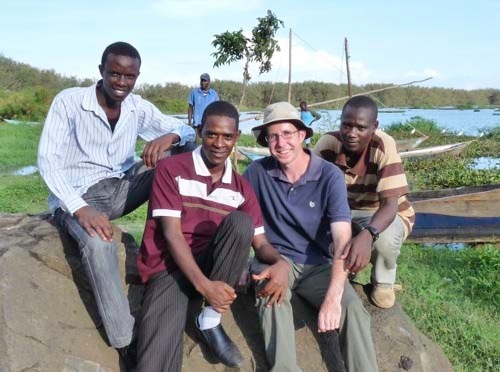Research Summer 2014
Fulbright Scholar studies renewable energy in Kenya
by Leah Twilley
Erik Nordman has always preferred coffee over tea, until recently.
During a Fulbright scholarship through the U.S. Bureau of Educational and Cultural Affairs, Nordman, associate professor of biology, spent last year in Kenya researching potential wind energy opportunities for tea farms in the country. He also taught environmental classes at Kenyatta University in Nairobi, the country’s capital.
“Tea is Kenya’s largest export crop and there are about 500,000 small, independent farmers who participate in cooperatives that process the tea,” Nordman said. “Kenya is the third largest producer of tea in the world.”
Nordman explained that before Kenya became an independent country in 1963, Kenyans were not allowed to grow tea. “There were and still are many tea estates owned by big companies like Unilever and Nestlé, but after the country became independent, the industry boomed for small farmers. Many people began growing their own tea bushes and formed the co-ops,” he said.

Erik Nordman and students majoring in environmental studies visit western Kenya during a field trip.
courtesy photo
The preparation process for tea includes oxidizing, drying and packaging freshly picked leaves at factories several stories tall shared by independent farmers. Nordman said the cost of electricity is twice as much as it is in the U.S., as there are inefficiencies and it can be unreliable.
“The tea-making process is simple, but there is a lot of energy required to light a factory and run the machines and motors,” he said. “So, I looked at whether operating a factory on wind power would be a cost-effective solution for the farmers, and I discovered that it would save them money.”
Using a technical economic model, Nordman hypothetically calculated how much it would cost to purchase, transport, install and maintain a 750-kilowatt, medium-sized wind turbine. He then compared that to the region’s wind resource and how windy it is in the region. He analyzed data collected from the Solar and Wind Energy Resource Data Set, provided by the United Nations Environment Program, to determine areas where wind power is strong. From there, he came up with an estimate of how much savings there would be compared to grid electricity.
“I found that in eastern areas near Mount Kenya the wind resource is sufficient enough that a wind turbine would save each tea factory about $60,000 a year,” said Nordman. “The climate in those areas is good for growing tea, especially because it gets cool in the evening and the elevation is 8,000-9,000 feet, compared to high humidity in western regions.”
He said over the course of 20 years — the average lifespan of a wind turbine — a turbine could return up to $515,000 in some areas. “Reducing production costs will increase the farmers’ profits, which will help their well-being and livelihood,” he said.
Nordman presented his yearlong research at the International Development Research Conference near Cape Town, South Africa, in 2013. He also shared it with the Kenya Tea Development Agency, an organization that oversees the country’s 63 cooperative tea factories. “They were receptive to my research project because energy issues have been a big concern for them,” he said.
He plans to present his findings with independent tea industries in other countries, such as China and India, which are, respectively, the first- and second-largest tea producing countries in the world. He is also starting to work with a Grand Valley student and Kenyatta faculty member on solar power potential in the same regions of Kenya and areas in Tanzania, another tea-producing country.
“We’re finding that in many cases, solar energy can save up to $200,000 a year in energy costs, which is really powerful,” he said.
Nordman wrote a blog about his experiences in Kenya,
www.nordmansustainability.com/blog.
